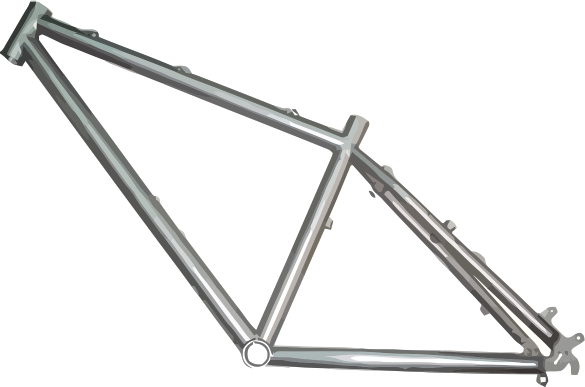The 4 Most Common Bicycle Frame Materials

I remember the days when there was only one material used for bike frames and that was steel. In terms of choosing a bike things were much easier back then. All you really had to worry about was the color. Now, there are about half a dozen types of materials that you can choose from and sometimes those types can even be combined.
The type of bike frame material you choose from should be determined by:
- How serious of a rider you are e.g. do you ride in the park on Sunday afternoons or do you race on a team?
- Your budget.
- How long you plan on keeping the bike e.g. steel, if kept clean, will last the longest.
- The type of riding you plan on doing, e.g. mountain or road biking.
- Your weight. If you are on the bigger side make sure you get a frame that is stronger and can take the pounding especially if you plan on doing off road riding. Steel and titanium may be better for you as they can flex more before breaking.
The most common frames today include: steel, aluminum, carbon fiber, and titanium. However, there are also frames made of wood, bamboo, thermoplastic, and magnesium. There are even frame materials consisting of cardboard and plastic.
Steel Frames
At one time was the only frame material. It is sturdy and can withstand quite a bit of abuse. It is cheap and, if needed, it can be bent back into shape after an accident. Steel also allows for a bit of give, therefore providing a more comfortable ride compared to some other materials. The disadvantages are that it can't be built into all of the strange shapes you see today. It is also a very heavy material, although steel frames today are much lighter than they were several years ago. Some experts believe that with technology, steel frames will make somewhat of a comeback. In terms of accidents, steel will bend but it will not splinter like carbon fiber.
Aluminum:
This material seems to be the most popular today for most riders. It can be built into a variety of shapes, it is much lighter than steel, and it is less prone to corrosion than steel. However, it is more expensive than steel, but not as expensive as other materials. It is also not as strong as steel. If you choose to go aluminum research the quality of the frame as they do differ. It is possible to buy a cheap aluminum frame that will be heavier than a high quality steel frame.
Carbon Fiber:
This material has quickly gained ground in the last few years. Its advantages are its weight, which is less than aluminum, and that it can be designed easily into any shape imaginable. A frame made of carbon fiber can be stronger in some areas while more flexible in others. Carbon fiber is also corrosion resistant. Disadvantages include a high cost and lower impact resistance. In a crash it is more likely to break and instead of bending it may simple shatter into pieces, which can be dangerous for the rider. Obviously, this type of frame cannot be repaired or bent back into shape.
Be aware that there different grades of carbon fiber frames, which will contribute to its strength and ride quality. The layering of the fibers and the direction of the layering all impact the finished product and you shouldn't expect all of them to be of the same quality. Carbon fiber also seems to be more prone to material fatigue and there is usually no warning prior to breaking.
Titanium:
If it wasn't for the higher cost this frame material would be much more popular. It has a high strength to weight ratio (compared to others), is very corrosive resistant, and is fairly stiff. It is also a bit exotic, imagine telling your riding buddies that your bike is made of titanium.
As mentioned, there are other frame materials, but the above are the most common. They have retained their popularity because of their desirable features and their cost.




Leave a Reply